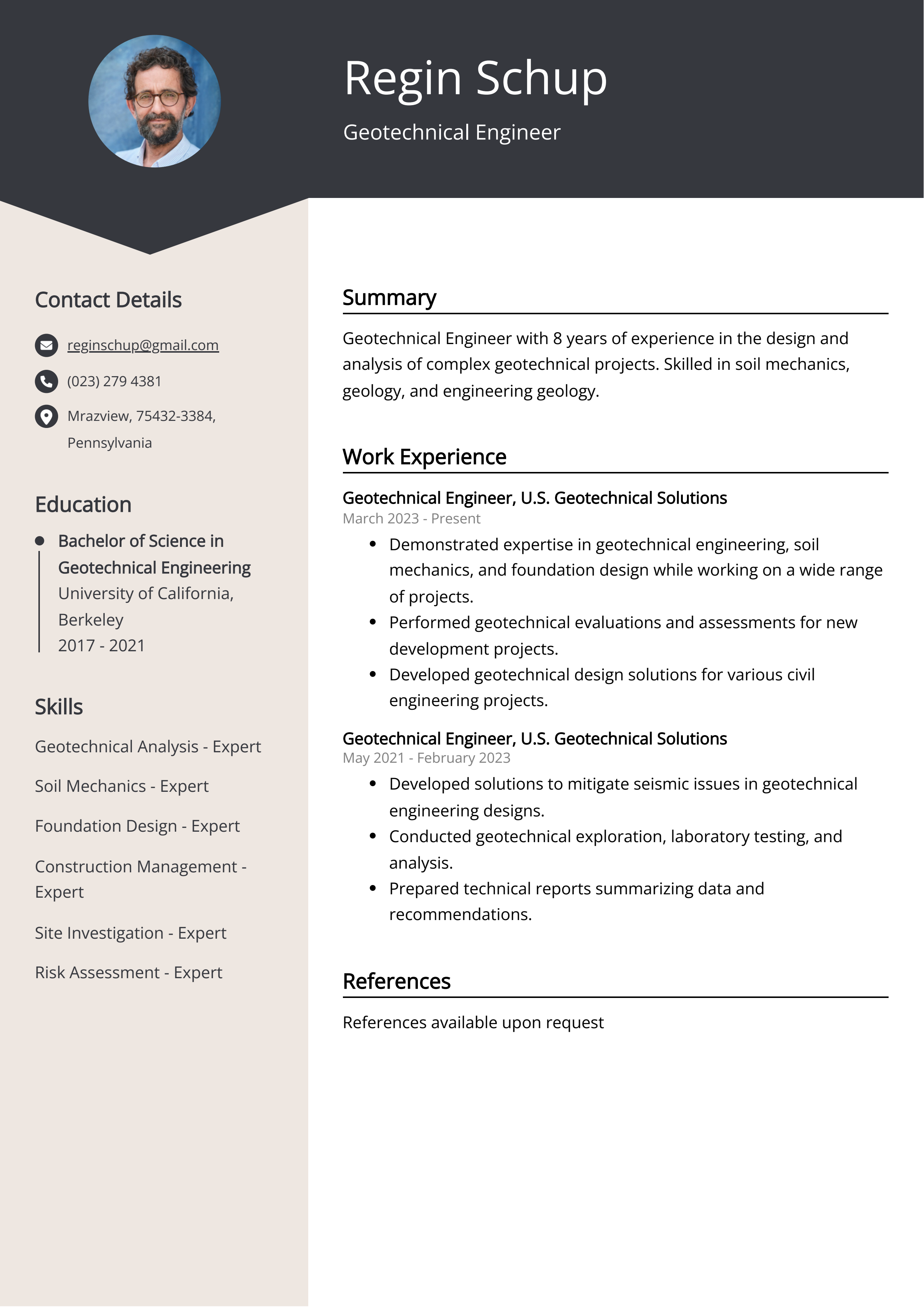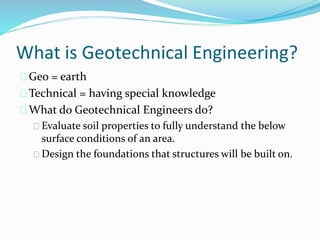The Main Principles Of Geotheta
The smart Trick of Geotheta That Nobody is Discussing
Table of ContentsGeotheta Fundamentals ExplainedThe 15-Second Trick For GeothetaFacts About Geotheta RevealedGetting My Geotheta To WorkThe Basic Principles Of Geotheta

They conduct website investigations, gather samples, do research laboratory tests, and analyze information to review the viability of the ground for building jobs - Consulting Engineers. Based upon their findings, geotechnical designers provide recommendations for structure design, slope stability, keeping structures, and reduction of geotechnical risks. They work together with other experts, such as engineers, architectural engineers, and building groups, to make sure that geotechnical factors to consider are incorporated into the general job layout and implementation
By evaluating the habits and buildings of soil and rock, they can recognize prospective geotechnical threats such as landslides, soil negotiation, or incline instability. Their experience aids protect against failures or crashes that could jeopardize lives and home. Below are some detailed obligations and responsibilities of a geotechnical engineer: Website Examination: Geotechnical designers conduct site examinations to gather information on subsurface problems.
They analyze the information to recognize the residential or commercial properties and behavior of the soil and rock, including their toughness, leaks in the structure, compaction qualities, and groundwater problems. Geotechnical Evaluation and Layout: Geotechnical engineers examine the information gathered during site examinations to assess the security and viability of the site for construction projects. They carry out geotechnical estimations and modeling to evaluate elements such as birthing ability, settlement, incline stability, side earth pressures, and groundwater flow.
The 7-Minute Rule for Geotheta
Structure Layout: Geotechnical designers play a crucial role in designing structures that can safely support the intended framework. They assess the soil conditions and lots requirements to figure out the ideal structure kind, such as shallow structures (e.g., footings), deep structures (e.g (http://go.bubbl.us/e3adfd/a28b?/Geotheta)., heaps), or specialized methods like dirt renovation. They consider variables such as negotiation restrictions, birthing capability, and soil-structure interaction to develop optimal foundation layouts
They evaluate building and construction strategies, monitor website tasks, and perform area inspections to verify that the style suggestions are complied with. If unanticipated geotechnical problems emerge, they analyze the scenario and provide recommendations for remediation or changes to the style. Risk Assessment and Reduction: Geotechnical engineers analyze geotechnical risks and risks connected with the task website, such as landslides, liquefaction, or soil erosion.

Partnership and Communication: Geotechnical engineers work carefully with other experts entailed in a project, such as architects, architectural designers, and building groups. Reliable communication and partnership are important to incorporate geotechnical factors to consider right into the overall task style and construction procedure. Geotechnical designers offer technical proficiency, solution queries, and make sure that geotechnical demands are satisfied.
The 6-Second Trick For Geotheta
Right here are some kinds of geotechnical designers: Structure Engineer: Structure designers focus on creating and examining structures for structures. They evaluate the soil conditions, load requirements, and site qualities to identify one of the most suitable structure kind and design, such as superficial foundations, deep foundations, or specialized techniques like pile structures.
They review the elements affecting slope security, such as dirt residential or commercial properties, groundwater conditions, and incline geometry, and create methods to prevent slope failings and alleviate threats. Quake Engineer: Quake engineers focus on assessing and making frameworks to endure seismic pressures. They analyze the seismic risk of a website, review soil liquefaction possibility, and create seismic style requirements to make certain the security and strength of frameworks throughout earthquakes.
They execute field screening, gather samples, and evaluate the accumulated information to define the soil homes, geologic formations, and groundwater problems at a website. Geotechnical Instrumentation Designer: Geotechnical instrumentation designers concentrate on surveillance and determining the actions of dirt, rock, and structures. They install and keep instrumentation systems that keep track of aspects such as dirt negotiation, groundwater degrees, incline movements, and structural displacements to analyze performance and offer early warnings of possible problems.
The Buzz on Geotheta
They perform examinations such as triaxial tests, debt consolidation examinations, direct shear examinations, and leaks in the structure tests to collect data for geotechnical evaluation and style. Geosynthetics Designer: Geosynthetics engineers focus on the design and application of geosynthetic products, such as geotextiles, geogrids, and geomembranes. They make use of these materials to enhance dirt stability, enhance slopes, give water drainage solutions, and control erosion.
They often tend to be investigatory individuals, which indicates they're intellectual, introspective, and inquisitive. They are interested, methodical, logical, analytical, and logical. Some of them are likewise social, implying they're kind, generous, participating, individual, caring, useful, empathetic, sensible, and friendly - Consulting Engineer.
In the workplace setting, geotechnical designers utilize specialized software application tools to execute computations, produce designs, and analyze data. They prepare records, review job specifications, interact with customers and staff member, and coordinate project tasks. The workplace setting provides a helpful atmosphere for research, analysis, and collaboration with other specialists included in the project.
3 Simple Techniques For Geotheta
They regularly check out job sites to perform site investigations, evaluate geotechnical problems, and gather information for evaluation. These visits entail traveling to different locations, occasionally in remote or tough terrains. Geotechnical engineers might carry out soil tasting, conduct examinations, and monitor building and construction tasks to make certain that the geotechnical facets of the job are being carried out properly.
Geotechnical designers additionally work in specialized geotechnical research laboratories. Geotechnical lab engineers function extensively in these environments, handling testing devices, operating instruments, and tape-recording data.